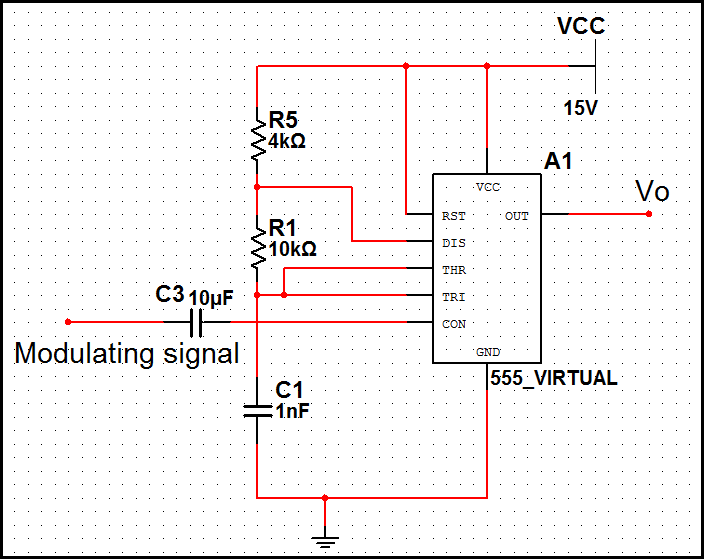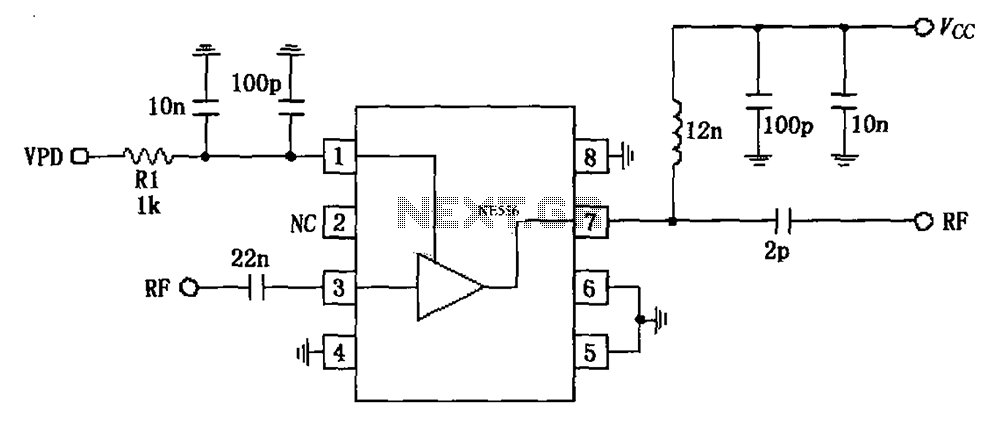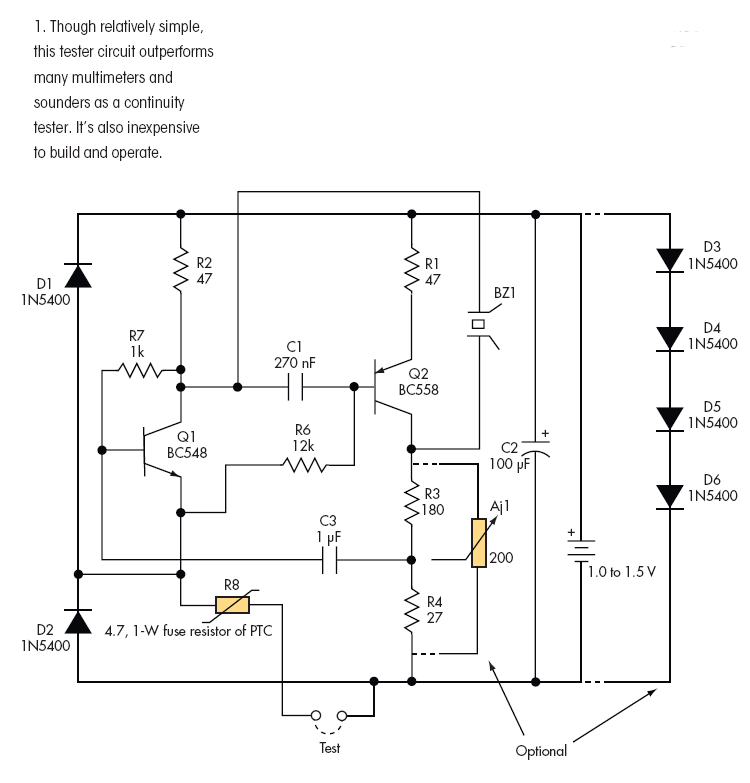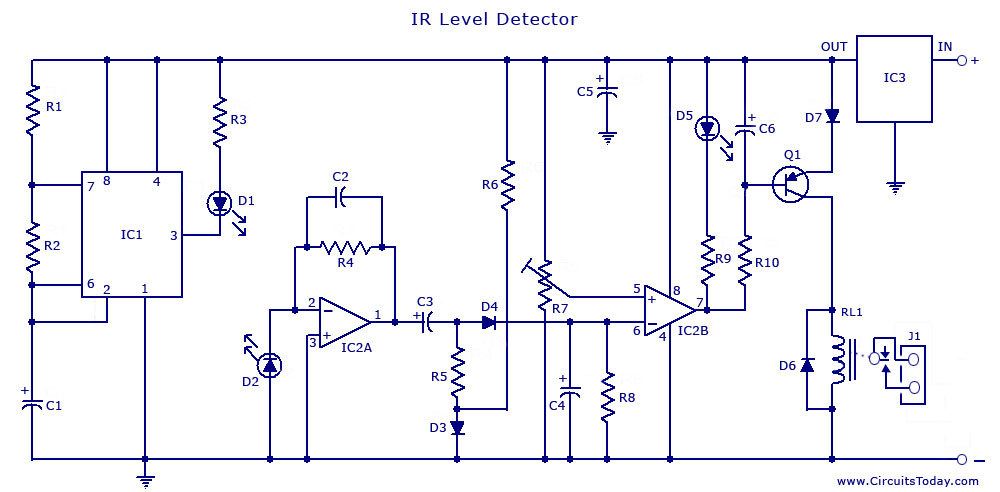
How To Build A One-Time-Only >> Burglar Alarm Circuit
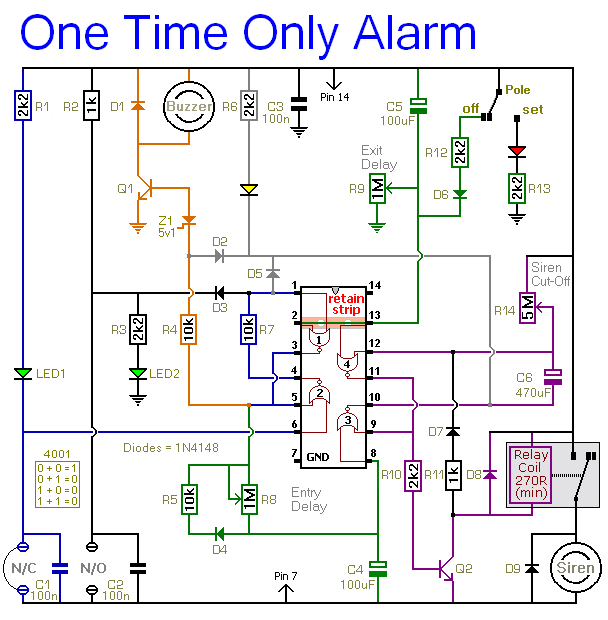
This alarm is designed to activate its siren only once. When the alarm is triggered, the siren will sound for a predetermined duration before automatically turning off and remaining inactive. The alarm system features a single zone with independently adjustable exit and entry delays. It can accommodate various types of normally-open and normally-closed input devices, including pressure mats, magnetic reed contacts, micro switches, foil tape, and passive infrared sensors (PIRs). A selection of expansion modules allows for the addition of multiple instant alarm zones, personal attack zones, and tamper zones. Additionally, there is an untimed output module that can keep an internal sounder, strobe light, lamp, or similar device activated after the siren has stopped. The alarm can be operated using a concealed two-way switch, such as a light switch, or for enhanced security, a key switch or various code-operated keypad switches may be utilized. Before activating the alarm, it is essential to ensure that the premises are secure, indicated by all green LEDs lighting up and the yellow LED being off. If the yellow LED is illuminated, it indicates a fault in one of the zones, preventing the alarm from being set. Depending on the configuration of resistor R9, moving switch SW1 to the "set" position allows for approximately one minute to exit the building. Upon returning and opening the door, a buzzer will sound. Based on the setting of resistor R8, there is a window of about one minute to deactivate the alarm. Failure to do so will result in the siren sounding. According to the setting of resistor R14, the siren may sound for up to approximately 20 minutes before it automatically turns off and remains silent. However, the alarm can be silenced at any time by moving switch SW1 to the "off" position.
The alarm circuit is structured around a microcontroller or a dedicated alarm IC that manages the activation and timing of the siren. Input from various sensors is processed through a series of comparators and logic gates to determine if an alarm condition has been met. The system includes a power supply circuit to ensure stable operation, typically using a battery backup to maintain functionality during power outages.
The user interface is facilitated through a keypad or a series of switches, allowing for easy programming of exit and entry delays, as well as the activation of different zones. Visual indicators, such as LEDs, provide real-time feedback on the system's status, including operational readiness and fault conditions.
The expansion modules are connected via a bus system, enabling easy integration of additional zones without significant modifications to the base circuit. Each zone is monitored continuously, and any fault detected will interrupt the arming sequence, ensuring that the system remains secure at all times.
In summary, this alarm system is designed for reliability and ease of use, featuring a robust architecture that allows for scalability and adaptability to various security needs. The careful selection of components and configuration parameters ensures that the system can be tailored to specific environments while maintaining high levels of security.This alarm is designed to sound its Siren only once. That is - when the alarm is activated - the Siren will sound for a preset length of time. Then it will switch off and remain off. The alarm will not re-activate. The basic alarm has a single zone with independently adjustable Exit and Entry delays. The zone will accommodate the usual types of no rmally-open and normally-closed input devices - such as pressure mats, magnetic-reed contacts, micro switches, foil tape and PIRs. A range of Expansion Modules allow you to add any number of Instant Alarm Zones, Personal Attack Zones and Tamper Zones to your system.
There`s also an Untimed Output Module. It will keep an internal sounder, strobe-light, lamp or whatever going after the siren has stopped. The alarm may be operated by a simple hidden two-way switch - such as a light switch. If you want more security - you can use a key switch - or one of a number of code operated Keypad Switches. Before you set the alarm - make sure that the building is secure - that ALL of the Green LEDs are lighting - and that the Yellow LED is off.
If the Yellow LED is lighting - there`s a fault in one of the zones - and THE ALARM WILL NOT SET. Depending on the setting of R9 - when you move Sw1 to the "set" position - you have up to about a minute to leave the building. When you return and open the door - the Buzzer will sound. Depending on the setting of R8 - you have up to about a minute to switch the alarm off. If you fail to do so - the Siren will sound. Depending on the setting of R14 - the Siren will sound for up to about 20-minutes. Then it will switch off - and remain off. Of course - you can stop the noise at any time by moving Sw1 to the "off" position. 🔗 External reference
The alarm circuit is structured around a microcontroller or a dedicated alarm IC that manages the activation and timing of the siren. Input from various sensors is processed through a series of comparators and logic gates to determine if an alarm condition has been met. The system includes a power supply circuit to ensure stable operation, typically using a battery backup to maintain functionality during power outages.
The user interface is facilitated through a keypad or a series of switches, allowing for easy programming of exit and entry delays, as well as the activation of different zones. Visual indicators, such as LEDs, provide real-time feedback on the system's status, including operational readiness and fault conditions.
The expansion modules are connected via a bus system, enabling easy integration of additional zones without significant modifications to the base circuit. Each zone is monitored continuously, and any fault detected will interrupt the arming sequence, ensuring that the system remains secure at all times.
In summary, this alarm system is designed for reliability and ease of use, featuring a robust architecture that allows for scalability and adaptability to various security needs. The careful selection of components and configuration parameters ensures that the system can be tailored to specific environments while maintaining high levels of security.This alarm is designed to sound its Siren only once. That is - when the alarm is activated - the Siren will sound for a preset length of time. Then it will switch off and remain off. The alarm will not re-activate. The basic alarm has a single zone with independently adjustable Exit and Entry delays. The zone will accommodate the usual types of no rmally-open and normally-closed input devices - such as pressure mats, magnetic-reed contacts, micro switches, foil tape and PIRs. A range of Expansion Modules allow you to add any number of Instant Alarm Zones, Personal Attack Zones and Tamper Zones to your system.
There`s also an Untimed Output Module. It will keep an internal sounder, strobe-light, lamp or whatever going after the siren has stopped. The alarm may be operated by a simple hidden two-way switch - such as a light switch. If you want more security - you can use a key switch - or one of a number of code operated Keypad Switches. Before you set the alarm - make sure that the building is secure - that ALL of the Green LEDs are lighting - and that the Yellow LED is off.
If the Yellow LED is lighting - there`s a fault in one of the zones - and THE ALARM WILL NOT SET. Depending on the setting of R9 - when you move Sw1 to the "set" position - you have up to about a minute to leave the building. When you return and open the door - the Buzzer will sound. Depending on the setting of R8 - you have up to about a minute to switch the alarm off. If you fail to do so - the Siren will sound. Depending on the setting of R14 - the Siren will sound for up to about 20-minutes. Then it will switch off - and remain off. Of course - you can stop the noise at any time by moving Sw1 to the "off" position. 🔗 External reference
Warning: include(partials/cookie-banner.php): Failed to open stream: Permission denied in /var/www/html/nextgr/view-circuit.php on line 713
Warning: include(): Failed opening 'partials/cookie-banner.php' for inclusion (include_path='.:/usr/share/php') in /var/www/html/nextgr/view-circuit.php on line 713

